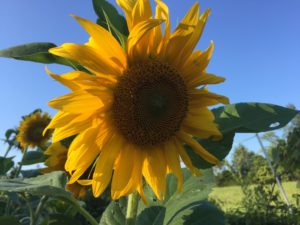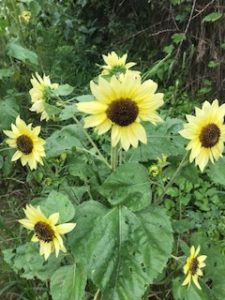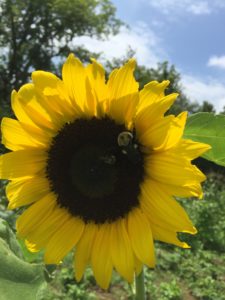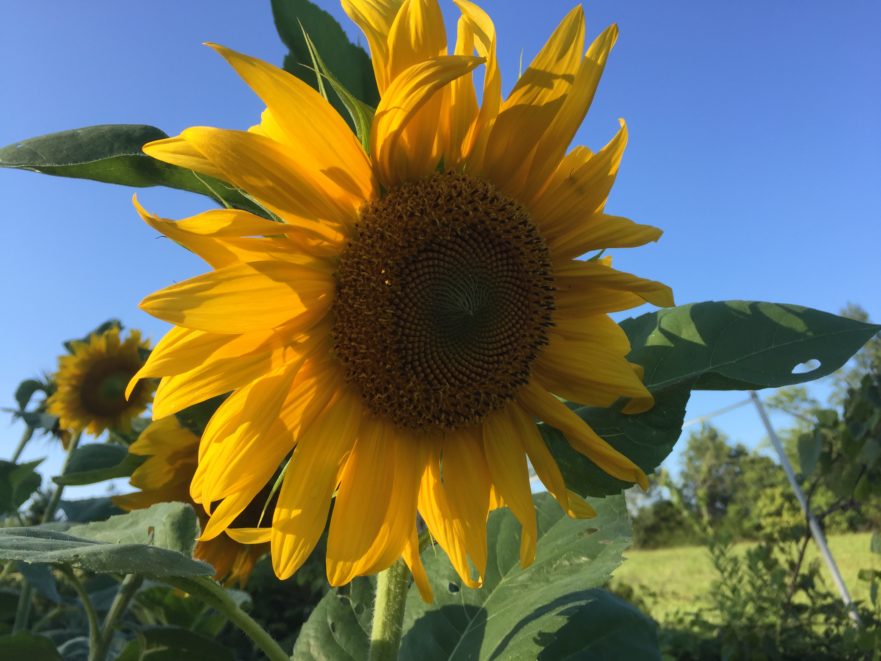
“Keep your face to the sunshine and you cannot see the shadows. It’s what sunflowers do.” ~Helen Keller
Sunflowers make me smile. I once titled one of my Heart of Hollyhill books, Sunflowers of Joy. That title was eventually changed to Summer of Joy, but my first idea for a title showed how I think of sunflowers as something that can make us happy.
 We’ve had fun over the years growing them in our vegetable garden. We’ve had various varieties which can be fun too. Once I had some that were thick and fluffy like a carnation. A big, very yellow carnation. This year we have a variety all in the same row. Some are tall with big seed filled blooms. One is more of a pale yellow with multiple small blooms. Others have orange highlights and are more petals than seeds. Then we have the ones with clusters of blooms rising high above the garden fence to reach for the sun.
We’ve had fun over the years growing them in our vegetable garden. We’ve had various varieties which can be fun too. Once I had some that were thick and fluffy like a carnation. A big, very yellow carnation. This year we have a variety all in the same row. Some are tall with big seed filled blooms. One is more of a pale yellow with multiple small blooms. Others have orange highlights and are more petals than seeds. Then we have the ones with clusters of blooms rising high above the garden fence to reach for the sun.
All these sunflowers profusely blooming made me wonder about sunflower quotes and then that led me to an internet post that didn’t simply have quotes but also information about the sunflowers. Here’s some of what I found. First, sunflowers have been growing here in North America for a very, very long time. The same as potatoes, tomatoes, and corn, sunflowers didn’t originate in Europe. They were cultivated in North America as far back as 3000 B.C. Historians believe they were originally developed for food, medicine, dye, and oil. Later, in the 1500s, Spanish conquistadors took the sunflower seeds to the rest of the world and sunflowers were soon everywhere.
Sunflowers display a behavior called heliotropism. The young blossoms will face east in the morning and follow the sun as the earth moves during the day. This is something I’ve never noticed, but I’ll have to pay attention next year. As the flowers get heavier during seed production, the stems get stiffer and the mature flower heads generally remain facing east. Sometimes in my garden the flower heads get so heavy they fall over. Then I cut them and hang them in a tree for the birds. Oh, and the bees love the blooms too.
“I want to be like a sunflower; so that even on the darkest days I will stand tall and find the sunlight.” (Unknown source)
The blooms were for more than beauty or food among Native Americans. A number of tribes believed the plant had curing properties. The Cherokee utilized an infusion of sunflower leaves to treat kidneys while the Dakotas thought it soothed chest pain and pulmonary troubles.
Whatever the flowers and seeds are used for, those acres and acres of sunflowers grown as crops are always cheerfully beautiful. We don’t grow ours for any purpose other than the sight of the bright blooms and as feed for the birds, but that’s plenty of reason to plant a few sunflower seeds in the spring to enjoy seeing them reach for the sun all through the garden season.
I don’t think there’s anything on this planet that more trumpets life than the sunflower. For me that’s because of the reason behind its name. Not because it looks like the sun but because it follows the sun. During the course of the day, the head tracks the journey of the sun across the sky. A satellite dish for sunshine. Wherever light is, no matter how weak, these flowers will find it. And that’s such an admirable thing. And such a lesson in life. ~Helen Mirren
Have you ever grown sunflowers? Do they make you smile?
Thanks, as always, for reading.


Comments 7
That is not only the storms, but also, the sunflowers popping up in unusual places.
Hasn’t happened since and am praying that it doesn’t ever again in our lifetime. 🙏🏻
Author
I can understand that. That was one storm we never want to see repeated or anywhere close, Karen. We can just plant those sunflower seeds where we want them.
I try to grow some every year. This year the storms kept knocking them over.
Author
High winds are hard on them, Lucy, especially after they get heavy with seeds. We’ve already had a few hit the dirt.
I’ve never purposely grown sunflowers, but my grandfather and daughter have. After Katrina they started popping up all over the Gulf Coast giving us a ray of sunshine at a very dismal time. We attributed it to the washing out of bird feeders in the area. 😊
Author
That’s interesting, Karen. However it happened, the Lord used it to bring a little brightness to, as you say, a dismal time. I’ve actually not had that many come up volunteer. One once under my birdfeeder. Guess the birds make sure hardly any seeds escape. Then another time one came up in a flowerpot. A bird must have planted it. 🙂 But in spite of many seeds escaping in the garden, we’ve not had any volunteer plants and have to plant seeds each year. Of course, we do plow up the garden again each year, but you’d think a stray plant would pop up somewhere now and again.